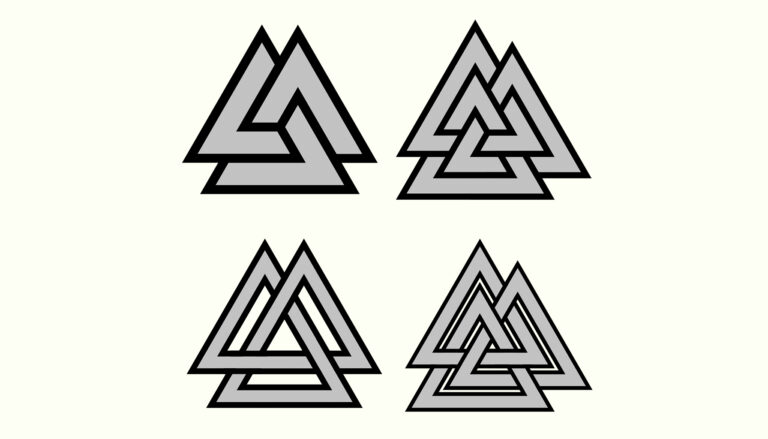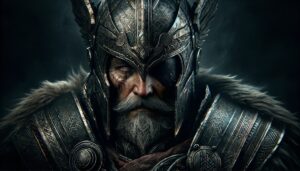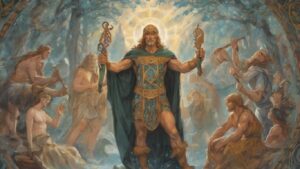Table of Contents
Origins
The Valknut, a symbol from Norse mythology, comprises three interlocking triangles. Its name originates from two Old Norse words: “valr,” signifying “slain warriors,” and “knut,” denoting “knot.” Although its precise origins remain obscured in history, ancient Norse artifacts have yielded the Valknut, suggesting its importance in Viking culture.
Insights from Ancient Norse Artifacts
Various ancient Norse artifacts indeed reveal the presence of the Valknut symbol, shedding light on its historical importance. These artifacts primarily originate from the Viking Age, spanning from the late 8th century to the early 11th century. Additional details include:
Artifacts: Researchers have discovered the Valknut on a range of items, including runestones, burial stones, amulets, and personal belongings. These objects have strong associations with Viking-era Scandinavia.
Runestones: Runestones, erected during the Viking Age to commemorate individuals, events, or achievements, frequently feature the Valknut symbol. It often accompanies runic inscriptions, reinforcing its connection to the warrior’s fate and the afterlife.
Burial Sites: The Valknut appears on burial stones and monuments, emphasizing its link to death, warriors, and the idea of fallen heroes joining Odin in Valhalla after heroic deaths in battle.
Amulets and jewelry have revealed the symbol, which people believe Viking warriors and individuals wore as protective charms, further emphasizing its role as a symbol of protection.
Geographic Range: The Valknut’s presence extends across different parts of the Viking world, including Scandinavia and regions influenced by Viking settlements, such as the British Isles and parts of continental Europe.
Continued Significance: Even in modern times, the symbol retains its importance. In the context of Norse heritage and Viking culture, people frequently use it as a symbol representing strength, protection, and a connection to the warrior ethos of the past.
Symbolic Interpretations
The Valknut’s meaning has been the subject of much debate among scholars and enthusiasts. It is often associated with Odin, the chief of the Norse gods, and his role as a chooser of the slain. Here are some interpretations:
Death and the Afterlife. One prevailing interpretation sees the Valknut as a symbol of the transition between life and death. It is thought to represent the warriors who died in battle, chosen by Odin to join him in Valhalla, the hall of heroes.
Protection. Another interpretation suggests that the Valknut served as a symbol of protection in battle. Warriors may have worn it to seek Odin’s favor and his divine protection during combat.
Odin’s Power. Due to its association with Odin, the Valknut is sometimes considered a symbol of the Allfather himself. It may represent his power, authority, or his ability to bind and unbind the fates of individuals.
Triad of Realms. The three interlocking triangles of the Valknut have also represented the triad of Norse realms: Asgard (realm of the gods), Midgard (realm of humans), and Helheim (realm of the dead) in various interpretations.
Abilities and symbology
The Valknut symbol, devoid of magical powers in Norse mythology, holds profound significance. It represents key concepts closely tied to life, death, fate, and the god Odin.
Firstly, the Valknut emphasizes interconnectedness within Norse cosmology’s cyclical framework, where life and death are intricately linked.
Secondly, it’s associated with death and the afterlife, appearing on burial stones, symbolizing fallen warriors’ journey to Valhalla, chosen by Odin.
Additionally, the Valknut signifies the role of fate, woven by the Norns, reinforcing Odin’s power and authority.
Moreover, its triadic nature reflects the three realms in Norse cosmology: Asgard, Midgard, and Helheim, emphasizing interconnectedness.
Lastly, the Valknut is a symbol of Odin, representing his role as chooser of the slain and his pursuit of wisdom and knowledge, essential aspects of Norse culture.
Cultural Impact
The Valknut has endured as a powerful symbol in modern times. It is often associated with Norse heritage, Viking warrior ethos, and the mysteries of the Norse gods. In contemporary culture, the Valknut has found its place in tattoos, jewelry, and art, serving as a connection to the ancient past and a reminder of the enduring spirit of the Viking age.
Norse mythology doesn’t centralize the Valknut in specific myths or stories but employs it as a pervasive symbol in various contexts. It often appears in association with Odin and the idea of the warrior’s fate in Valhalla.
Tattoo meaning
A Valknut tattoo holds several meanings making it a popular choice among those drawn to Norse mythology and Viking culture. Here are some key meanings, with transition words for clarity:
In connection to Norse Mythology. A Valknut tattoo signifies a connection to Norse mythology and ancient Viking traditions, paying homage to the rich history and beliefs.
Exemplifying the Warrior Spirit. The Valknut symbolizes bravery, courage, and the warrior spirit, echoing the fearless resolve of Viking warriors in the face of battle.
Offering Protection. Many opt for the Valknut as a protective symbol, believing it offers defense against harm, akin to how Viking warriors sought Odin’s favor for safeguarding in combat.
In Memory of Fallen Heroes. Linked to fallen warriors chosen by Odin for Valhalla, a Valknut tattoo becomes a tribute to and remembrance of loved ones who have passed away.
Signifying Interconnectedness. The Valknut’s interlocking triangles represent life-death interconnectedness, reflecting the cyclical nature of existence in Norse cosmology.
Embodying Fate and Destiny. The Valknut embodies the concept of fate and destiny. The Norns, weavers of fate, weave the threads of life, highlighting the interwoven paths in the grand tapestry of life.
Seeking Odin’s Wisdom. Given Odin’s close association with the Valknut, a tattoo featuring this symbol can symbolize a quest for wisdom, knowledge, and personal growth.
Embracing Viking Heritage. For those of Viking descent or those deeply appreciating Viking heritage, the Valknut tattoo signifies pride and cultural identity.
Encouraging Courage in Adversity. The Valknut serves as a reminder to confront challenges and adversity with courage, reminiscent of the resilience displayed by ancient Vikings in harsh conditions and battles.
FAQ
What does the word "Valknut" mean?
The word "Valknut" is derived from two Old Norse words: "valr" meaning "slain warriors" and "knut" meaning "knot."
What is the significance of the Valknut symbol?
The Valknut symbolizes various concepts, including interconnectedness, death and the afterlife, fate, and Odin's power.
How is the Valknut associated with interconnectedness?
The Valknut's interlocking triangles represent the interwoven nature of existence, emphasizing the connection between life and death in Norse cosmology.
What role does the Valknut play in Norse mythology?
It is often associated with Odin, the chief of the Norse gods, and his role as a chooser of the slain. It represents fallen warriors chosen to join him in Valhalla.
Is the Valknut a symbol of protection?
Yes, many believe the Valknut serves as a protective symbol, and it was worn by Viking warriors seeking Odin's favor for protection in battle.
Where has the Valknut symbol been found?
The Valknut has been found on various ancient Norse artifacts, including runestones, burial stones, amulets, and personal items.
What is the geographic range of the Valknut's presence?
The symbol has been discovered in different parts of the Viking world, including Scandinavia, the British Isles, and parts of continental Europe.
Does the Valknut symbol still hold significance today?
Yes, it continues to be important in modern times, often used in the context of Norse heritage, Viking culture, and as a symbol of strength and protection.
Can anyone use the Valknut symbol as a tattoo or in other forms of art?
Yes, the Valknut symbol is widely recognized and can be used by individuals interested in Norse mythology and Viking culture, as well as those seeking to symbolize various meanings associated with it.




